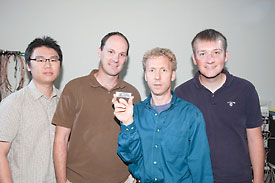It’s been called the sensor swarm, the sea of sensors and ubiquitous computing. It’s the idea that soon we’ll be living in a world where trillions of tiny electronic sensors monitor everything from the weather to the structural integrity of bridges to the temperature of milk cartons in a shipment.

A team of U-M students and faculty researchers, led by David Blaauw and Dennis Sylvester of the Department of Electrical Engineering and Computer Science, is developing some of the components needed to make that vision become reality.
Their latest prototype is a very-low-power microprocessor fitted with a miniature battery and four miniscule solar cells. The entire device is about the size of eight stacked grains of salt.
“Ubiquitous computing is one of the buzzwords for this idea of having sensors everywhere,” says Sylvester, an associate professor of electrical engineering and computer science. “Trillions of sensors sprinkled around the entire planet, all of which are part of a network accessible at the touch of a keystroke.”
The inventors plan to use their low-power technologies to launch a startup company in the coming months. Scott Hanson, who recently earned a doctorate from the university while developing ultra-low-power-circuit technologies, will lead the new Ann Arbor-based company.
Blaauw and Sylvester will present their latest work Oct. 13 at the annual Celebrate Invention reception. Sponsored by the Office of Technology Transfer, Celebrate Invention will feature exhibits by several U-M inventors. The event will be from 3-6 p.m. in the Michigan League Ballroom, 911 N. University Ave. For more information, go to www.techtransfer.umich.edu.
To date, the development of miniature sensor systems has been stymied by the high power consumption of the electrical components. Today’s components require bulky batteries to achieve the requisite multi-month or multi-year battery lifetimes.
Sylvester and Blaauw, a professor of electrical engineering and computer science, have spent the past five years developing ultra-low-power electronic components to solve this problem.
Last year they created a microprocessor that uses 30,000 times less power, when in standby or “sleep” mode, than comparable chips on the market. It was an important advance, since many sensors spend 99.9 percent of their lifetime in snooze mode, waking periodically to make a quick measurement.
By focusing their efforts on a highly efficient sleep mode, the researchers were able to dramatically shrink overall power consumption, which allowed their systems to operate with tiny batteries and for long periods of time.
The solar cells in their latest prototype system extend the unit’s lifetime indefinitely when used under modest lighting conditions.
The team’s long-term goal is to create cubic-millimeter-size computer sensor systems that cost just a few pennies apiece. The potential applications of these miniature, disposable, ultra-low-power sensors seem nearly as limitless as the lifetime of the new solar-powered prototype.
Sylvester and Blaauw already are working with researchers at the Medical School to create a pressure sensor that would be implanted, long-term, in the eyes of glaucoma patients. They also are looking into a pressure sensor that would be placed inside the skull of head-trauma patients to monitor brain swelling.
Inexpensive, disposable temperature tags could be placed on pharmaceuticals and foods — even wine bottles — to monitor temperature throughout the life of the product.
From environmental monitoring of water and air quality to military and national security applications related to surveillance, the list of possible uses goes on and on.
“This is all a bit further out, but we’re moving in that direction,” Blaauw says. “Very small sensor nodes will be monitoring the environment we’re living in, and then sending that information through laptops and cell phones back to data centers that do all the computation and data processing.”

